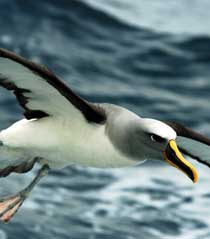|
Increased numbers of Buller's albatross on the Snares Islands, south of New Zealand, is giving hope that threatened albatross species could yet survive the world's fishing fleets.
Sea bird scientist Paul Sagar, who recently returned from the Snares, said a head count showed there were now about 8700 Buller's breeding pairs.
That was up more than 100 per cent on numbers when regular counts began in 1969.
Several albatross species have been brought to the brink of extinction, snagged in the bycatches of the world's fishing fleets.
But Mr Sagar said the Buller's had benefited from improved fishing methods.
Buller's have been one of the more common species killed in the bycatch of the long-line tuna fishery in New Zealand, and in the 1960s and 1970s the bird's survival was being significantly affected.
More than 65,000 albatross are believed to have died on long-line hooks within New Zealand's 200-nautical-mile exclusive economic zone in the past 20 years. However, long-lining has diminished and the remaining boats have adopted techniques to prevent bird bycatch.
The Buller's, which is about two-thirds the size of the southern royal albatross, is still regarded as vulnerable because it only breeds on New Zealand sub-Antarctic islands.
The Southern Seabirds Solutions Trust, an alliance of government departments, fishing companies and others has worked on changing fishing methods to reduce bird bycatch.
An international petition will be presented to the United Nations in June aimed at eliminating pirate fishing, which is thought to be causing a significant loss of albatross species.
Top
|
